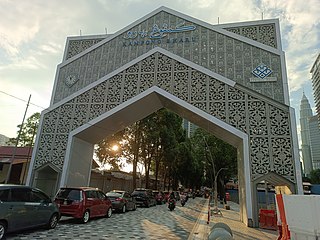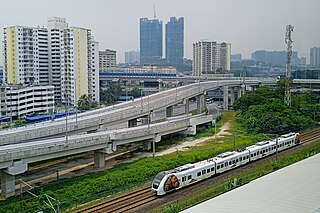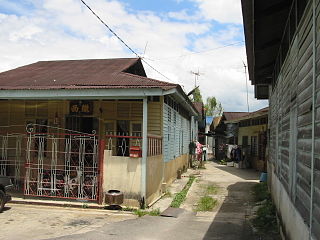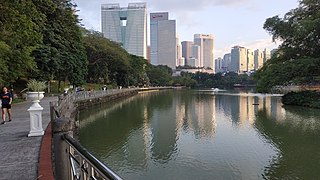
Bandar Utama Damansara is a residential township located within the Sungai Buloh mukim (subdivision) of the Petaling District, Selangor, Malaysia. It is a residential suburb and home to the popular 1 Utama Shopping Centre. Bandar Utama Damansara, together with neighbouring Kampung Sungai Kayu Ara, form the PJU 6 section of the city of Petaling Jaya.

Bangi, alternately Bangi Lama, is a small town situated south of Hulu Langat District, Selangor, Malaysia.

Pulau Ketam is an island located off the coast of Port Klang, Selangor, Malaysia. The island is in the intertidal zone and the chief vegetation is mangrove.
Taman Melawati is an affluent, self-contained town located in Ulu Klang, Selangor, Malaysia. Although the township's postcode is 53100, which gives it a Federal Territory postal address, it is actually in the Gombak constituency of Selangor, administered by the Ampang Jaya Municipal Council (MPAJ).

Kampung Baru or Kampong Bharu is a Malay enclave in central Kuala Lumpur, Malaysia. One of the most valuable tracts of land in the capital, it has been estimated to be worth up to US$1.4 billion.

Sungai Besi is a town and suburb within the Federal Territory of Kuala Lumpur. The federal constituency of Sungai Besi existed from 1974 to 1995. Sungai Besi was a historical mining town with many heavy industries such as steelworks, waste steel plants and other steel industries. Sungei Besi Tin Mine site was the largest and deepest open cast alluvial tin mine in the world and in Malaysia. The town has since developed from a large area of village settlements.

Setiawangsa is an eastern suburb in Kuala Lumpur, Malaysia, located less than 4 kilometres from the city centre and located right next to Ampang. There are 4 main residentials within this area;
- Taman Setiawangsa
- Tiara Setiawangsa
- Bukit Setiawangsa
- Puncak Setiawangsa

Sungai Siput (U) (Malay for 'snail river', Jawi: سوڠاي سيڤوت; Tamil: சுங்கை சீப்புட்; Chinese: 和豐市/和丰市) is a town and mukim in Kuala Kangsar District, Perak, Malaysia, covering 155.141 hectares, 61.5% of the total area of Kuala Kangsar. Sungai Siput falls under the management of the Kuala Kangsar Municipal Council.

New villages, also known as Chinese new villages, were internment camps created during the waning days of British rule in Malaysia. These camps were originally created as part of the Briggs Plan, first implemented in 1950 to isolate guerillas from their supporters within the rural civilian populations during the Malayan Emergency. Most were surrounded by barbed wire and watchtowers to stop people from escaping, with guards being ordered to kill anyone who attempted to leave outside of curfew hours.
The Bright Sparklers fireworks disaster occurred in Sungai Buloh, Selangor, Malaysia on 7 May 1991 at 3:45 (MST). The Bright Sparklers fireworks factory in Sungai Buloh, Selangor caught fire and caused a huge explosion. Twenty six people were killed and over a hundred people were injured in the disaster. The explosion was strong enough to rip off the roofs of some local houses, and ended up damaging over 200 residential properties and was felt as far as 7-8 kilometers from the side.

Sentul Timur LRT station is an elevated light rapid transit (LRT) station and serves as the terminal station for the Ampang Line and Sri Petaling Line. The station is located in Sentul, a suburb of Kuala Lumpur, which is surrounded by medium density low cost housing developments. Pangsapuri Melur is the nearest residential property to this station.
Bukit Bunga–Ban Buketa Bridge is a bridge crossing the Kolok River at the Malaysia–Thailand border, connecting Bukit Bunga town in Kelantan with Buketa village in Waeng District, Narathiwat Province, Thailand. It is the newest border crossing between Malaysia and Thailand and the third bridge crossing the Kolok river. The bridge was one of the co-operative projects under the framework of the Indonesia-Malaysia-Thailand Growth Triangle (IMT-GT).
Sunway City Ipoh is a township in Ipoh, Perak, Malaysia. It is located in Tambun. One of the famous attractions is Lost World of Tambun.

The Malaysia Agro Exposition Park Serdang is an agro park in Sepang District, Selangor, Malaysia. It is the largest agro park in Malaysia and Asia. It was created under an initiative by the Malaysian Ministry of Agriculture to be a venue for meetings, incentives, conferences and exhibitions (MICE), especially for those catering towards the agriculture, horticulture and agrotourism field.

The Kampung Batu station is a Malaysian commuter and Rapid transit train station located in the west side of and named after the village of Kampung Batu in northern Kuala Lumpur, Malaysia. It was built on the location of the disused colonial-era Batu Village railway station. The station is served by the KTM Komuter Seremban Line and the Putrajaya Line
Stadium UiTM is a stadium located at Shah Alam, Selangor, Malaysia. Its capacity is 10,000. The stadium was built for Universiti Teknologi MARA and the UiTM Football Club. SPA FC and Selangor F.C. also had used the stadium as their interim home ground. It can also be used as a rugby pitch. Activities organized by the university are sometimes held in the stadium.

Perdana Botanical Gardens, formerly Perdana Lake Gardens, Lake Gardens and Public Gardens, is Kuala Lumpur's first large-scale recreational park. Measuring 91.6 hectares, it is located in the heart of the city and established in 1888. The park served as place of refuge from the hustle and bustle of the city during colonial times. It contains large sculpted and manicured gardens and a host of attractions.

The Conlay MRT station, or Conlay–Kompleks Kraf station due to sponsorship reasons, is a mass rapid transit (MRT) station in Bukit Bintang subdistrict in central Kuala Lumpur, Malaysia. It is one of the stations under the Putrajaya Line.
The East Coast Rail Link (ECRL) is a standard gauge double-track railway link infrastructure project connecting Port Klang on the Straits of Malacca to Kota Bharu in northeast Peninsular Malaysia, connecting the East Coast Economic Region states of Pahang, Terengganu and Kelantan to one another, and to the Central Region of the Peninsula's west coast.
Kampung Bukit Lanchong is a small village in Subang Jaya, Selangor, Malaysia. The village is located between Puchong, UEP Subang Jaya (USJ), Putra Heights, Alam Megah (HICOM), Kota Kemuning and Bandar Saujana Putra. It is currently administered by the Subang Jaya City Council (MBSJ).












